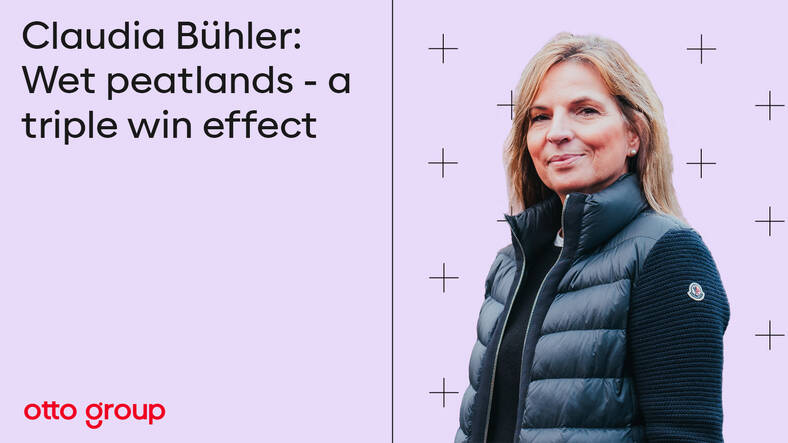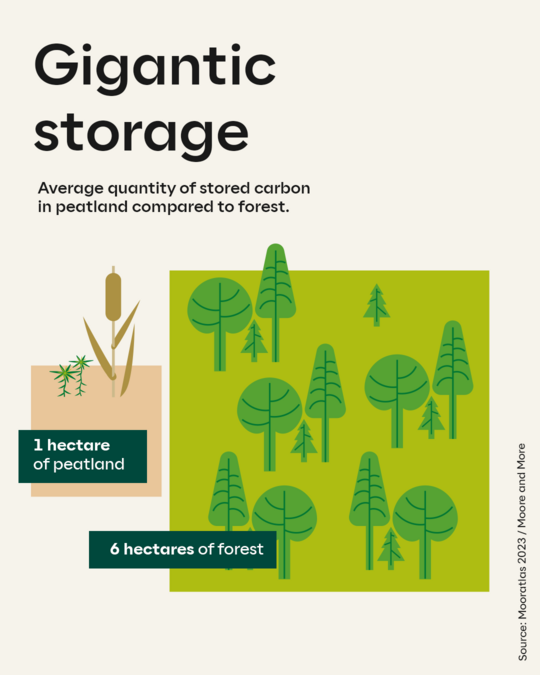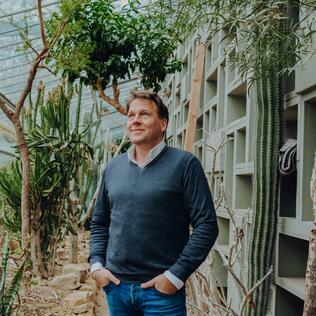Peatlands, the superheroes in the fight against the climate crisis

Peatlands can be found all over the world. They are fascinating ecosystems with many rare animal and plant species and what probably few people know is that they can store immense amounts of carbon - provided they are wet. Drained peatlands, on the other hand, have the exact opposite effect: they release harmful greenhouse gas emissions.
The Michael Otto Foundation for Environmental Protection and the Michael Succow Foundation, partner in the Greifswald Mire Centre, recognized early on how important wet peatlands are in the fight against climate change and the enormous potential they hold for the environment and the economy. They launched the toMOORow initiative, which is committed to the rewetting and sustainable use of peatlands, thus combining ecology with economy.
"The restoration and sustainable use of peatlands is of crucial importance for climate protection and the economy. This is why we at the Otto Group, together with our Group companies OTTO, Bonprix, Hermes Germany, the Witt Group, Baur and Systain Consulting, have supported the toMOORow initiative from the very beginning. It is committed to creating new, nature-friendly peatland habitats through rewetting and thus making a contribution to combating the climate crisis," says Prof. Dr. Tobias Wollermann, VP Corporate Responsibility of the Otto Group.
Wet peatlands as carbon reservoirs
Peatlands are true superheroes in the fight against the climate crisis. Although they only cover three percent of the global land area, they store twice as much carbon as the biomass of all the world's forests combined. In Germany, peatlands cover an area of around 1.8 to 1.9 million hectares. Around 95 percent of this is drained, partly for agricultural use. These drained peatlands are responsible for around seven percent of Germany's annual greenhouse gas emissions.
However, a healthy peatland acts as an effective carbon store. In the water-saturated environment, dead plant remains are not completely decomposed in the absence of oxygen and peat is formed. In this way, living peats grow slowly in height, about one millimeter per year. Together with the deposited organic material, the carbon is also fixed in the peat for thousands of years. When the peatlands are drained, however, the stored carbon is released again. Due to the lack of water, the peat comes into contact with air and chemical reactions take place. The carbon oxidizes and gradually escapes into the atmosphere in the form of CO2. As a result, drained peatlands are currently a significant source of greenhouse gas emissions.
Wet peatlands as natural flood protection
Wet peatlands also play an important role in nature's water balance. They act like sponges, absorbing water during periods of heavy rainfall and slowly releasing it again when it is dry. Studies have shown that intact peatlands can absorb around 90 percent of water during heavy rainfall and gradually release it again. Their water storage capacity is estimated to be around five times that of meadows, which makes them effective natural flood protection areas that can mitigate or even prevent flooding and help to regulate the groundwater level.
In times of climate change, which is leading to more frequent and intense weather extremes such as heavy rainfall, the preservation and restoration of these natural ecosystems is therefore invaluable.
Green treasure troves as an economic force
However, the rewetting of drained peatlands used for agriculture leads to changed soil conditions. The previous cultivation in the form of drained grassland and arable farming is then no longer possible, which means that farmers lose their source of income.
One possible solution is the sustainable management of wet peatlands, also known as paludiculture. In this approach, paludi biomass is obtained as a regional and renewable resource from wet peatlands, which can be used in various industries such as paper, packaging, construction, insulation or wood-based materials. The use of paludiculture opens up new perspectives both for agricultural businesses and for the economy, as it reduces the industry's dependence on fossil resources, mitigates shortages of original raw materials, and provides a climate-friendly and renewable alternative.
Activation of market forces for sustainable, climate-friendly economic activities
Among other things, the toMOORow initiative pursues the central goal of activating market forces and establishing scalable value chains. Specifically, the aim is to tap into the economic potential of paludiculture by channeling the biomass harvested from wet peatlands into the industrial manufacture of products from various sectors. By using the dynamics of supply and demand, the ultimate goal is to initiate positive changes for climate and species protection.
"In order for paludiculture to provide the necessary income potential for agriculture, the activation of market forces is absolutely essential," explains Claudia Bühler, Director of the Michael Otto Foundation for Environmental Protection. "To this end, we have established the Alliance of Pioneers - an association of strong, innovative companies that are committed to building scalable value chains with paludiculture biomass. The companies from different sectors will carry out pilot projects with paludi biomass in order to trigger the necessary demand pull for paludi biomass through industry-wide scaling. The aim is to create sources of income for agriculture if, after rewetting, the previous cultivation in the form of drained grassland or arable farming is no longer possible, while at the same time securing economic potentials for the companies. This way, effective climate and species protection can be achieved in conjunction with economic interests."
The Alliance of Pioneers was officially presented to the public on April 30, 2024 at an event in Berlin attended by the Federal Minister of Agriculture Cem Özdemir, the Federal Minister for the Environment Steffi Lemke and the two initiators of toMOORow Prof. Dr. Michael Otto and Prof. em. Dr. Michael Succow.
Acting responsibly together - with strong partners
The rewetting of drained peatlands is absolutely essential in order to achieve the Paris Agreement's goal of limiting global warming to a maximum of 1.5 degrees. The German government has also recognized this and initiated the first steps towards peatland transformation in 2022 with the national peatland protection strategy. The Otto Group is actively involved in raising awareness about the importance of peatlands. One concrete contribution to this is the support of the toMOORow initiative, which aims to develop sustainable solutions that benefit both climate and species protection as well as the economy. After all, peatlands are the superheroes in the fight against the climate crisis. Unlocking their full potential can only be achieved through collaboration - with strong partners from business, politics, agriculture, science, and civil society.









